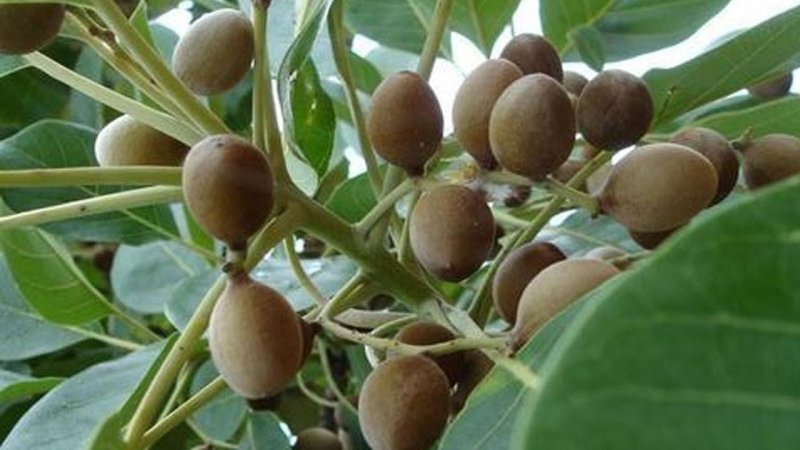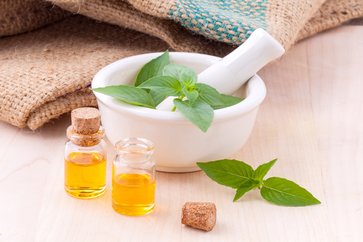Baheda Plant (Terminalia Bellirica) Benefits & Uses
Baheda fruit is known by various names such as Baheda, Bhibitaki, Bhaira, Bulla, etc. Baeda is used ranging from digestive disorders, respiratory problems, balancing of doshas, cough, and the common cold, for hair growth, relief from inflammation in rheumatism, etc.  It is an important fruit plant mention in Ayurveda text for its vast health benefits. It is one of the main ingredients, which is used for the herbal preparation Triphala, a Rasayana benefit ranging from weight loss to diabetes, and many more. The fruit is bitter in taste and has properties such an astringent, analgesic, expectorant, laxative, and brain tonic.
It is an important fruit plant mention in Ayurveda text for its vast health benefits. It is one of the main ingredients, which is used for the herbal preparation Triphala, a Rasayana benefit ranging from weight loss to diabetes, and many more. The fruit is bitter in taste and has properties such an astringent, analgesic, expectorant, laxative, and brain tonic.
Baheda is generally termed Belliric Myrobalan in English, and its botanical name is Terminalia Bellerica. In Sanskrit, the tree is known as Vibhita or Vibhitaka, which means fearless.
The Hindus of northern India generally believe that the person who will not sit beneath its shade will be inhabited by demons.
How does the plant Baheda look like?
Belliric Myrobalan Alternatively, the so-called Baheda is a large tree that grows up to the height to 40 m. The leaves are petiolate, broadly oval with clustered at the end of branches. The flowers are white or greenish-yellow, grows in single, simple looking grows with axillary spikes. The fruits are globe-shaped with a diameter about 1.5 – 2.5 cm in and when dry it looks obscurely 5- angled.
Where Does Baheda Tree Grow In India?
Baheda is a deciduous tree found throughout Indian in areas up to an altitude of 1,000 meters, in forests as well as plains. The Baheda tree is found in deciduous jungles throughout the larger part of India, except in the arid regions that are an area of upper Gangetic Plain, Chota Nagpur, Orissa, Bihar, Chittagong, West Bengal, Konkan, Deccan and most of the parts of South India.
Common Names
- Assamese: Bauri
- Bengali: Baheda
- English: Bedda nut tree, Belleric myrobalan, Belliric myrobalan
- Gujarati: Baheda
- Hin: Bhaira, Baheda
- Hindi: Bahuvirya, Baheda, Karshphal, Bhutvaas, Kalk
- Irula: Thandimaram
- Kannada: Thare, Tharo, Thani, Vibhita, Tare Mara, Taarekaayi, Taarekaayi Mara, Vibhitaka, Shanti Mara, Behara, Tara Mara
- Khasi: Dieng Rinyn
- Konkani: Goting
- Malayalam: Thannikka, Thanni, Tusham, Thani, Thannymathan, Adamarutha, Thaanni
- Manipuri: Baheda
- Marathi: Kalidruma, Baheda, Bibhitaka, Vehala
- Oriya: Bahada
- Sanskrit: Bahuvirya, Bibhitakah, Akshah, Vibhitakah, Kasaghnah, Karshah
- Tamil: Vibidagam, Semmaram, Kattuilupai, Tanri, Tani, Thandri, Akkam, Thaani, Tanri, Thandi
- Telugu: Tandrachettu, Tadi, Vibhitakamu, Bhutavasamu, Karshaphalamu
- Urdu: Baheda
Other Name
- Bastard Myrobalan
- Barro
- Bedda Nut Tree
- Thani
- Thandri
- Baheda
- Beleric yrobalan
- Bolsuiri
- Belliric Myrabolan
- Beach Almond
- Agong
Chemical Constituents Of Baheda Plant
Stem Bark
- Arjungenin
- Glycosides
- Belleric acid
- Bellericosides
Fruits
- Containhexahydroxydiphenic acid ester
- B-sitosterol
- Gallic acid
- Ellagic acid
- Ethyl gallate
- Galloyl glucose
- Chebulagic acid
- Mannitol
- Glucose
- Galactose
- Rhamnose
Ayurvedic view
Terminalia belerica or so-called Baheda is widely used in Ayurveda, Siddha, Chinese medicine, etc. According to Charaka Samhita (Ancient Indian Scripture), Baheda is known as “Vibheetaki” which means fear. Here the name “Vibheetaki” is termed as one who keeps you away from disease. The fruit is bitter in taste with astringent, analgesic, expectorant, laxative with brain tonic in nature.
It is a fruit that increases the dryness of tissues and is a lite to digest. It has an astringent (Kashaya Rasa) taste and gets a sweet (Madhura Rasa) taste after digestion. Besides this, it is hot in potency and boosts metabolism and normalizes all three doshas especially reduces kapha.
Ayurvedic Properties
- Rasa (Taste): Kashaya (Astringent)
- Guna (qualities): Rooksha (dry), Laghu (light to digest)
- Vipaka (taste conversion after digestion): Madhura (sweet)
- Veerya (potency): Ushna (hot)
Tridosha Effect
- Effect on Tridosha – Balances Kapha and Pitta.
Parts of the plant used
- Bark
- Fruits Peel
- Seed
- Seed kernel
Baheda Plant Properties And Uses
Tree Bark: The bark of the Baheda plant is mildly diuretic and is useful in anemia and leucoderma.
Unripe Fruits are anti-inflammatory, antihelmintic, expectorant, ophthalmic, antipyretic, and antiemetic. Fruits are useful in cough, asthma, bronchitis, dropsy, dyspepsia, cardiac disorders, skin diseases, leprosy, ulcer, and myocardial depressive activity
Ripe Fruits: used as astringent in combination with chebulic myrobalan (Terminalia chebula) and Phyllanthus emblica as the famous Triphala drug of Ayurveda. Fruits are also useful in eye diseases and scorpion sting
Medicinal uses of Baheda in Ayurveda
- Bhedanam: It has laxative action
- Chardi: Vomiting
- Chakshushya: Beneficial for eyes
- Kruminashanana: Relieves worm infestation
- Kasanashanam: Relieves cough and cold
- Kanthya: Effective for throat
- Keshya: Promotes hair growth and hair quality
- Madakrit: It is a natural sedative so very useful in disturbances like insomnia etc.
- Rasayan: Rejuvenating in nature
- Vaisvaryanashana: relieves hoarseness of voice
- Trit chhardi hari: It relieves excessive thirst and nausea
Medicinal Uses & Health Benefits of Baheda Churna
Bibhitaki, the wonder medicine has several health benefits, some of them are mentioned below:
1. It Helps in Weight Loss
Baheda fruit can be the best option for the Persons seeking for weight loss. Ayurvedic principles say that the herbs which have an astringent taste tend to shrink fat tissues. The fruit Baheda has astringent taste (Kashaya rasa) and is light to digest (Laghu) and causes dryness of tissues (Rooksha).
Besides this, it is hot potency (Ushna Veerya) in nature. So that person seeking for losing belly fat or weight loss can shrink the fat tissues using this herb. As Baheda fruit is light to digest it boosts body fire (Agni) the increased body fire accelerates metabolism and turns metabolism accumulated fat.
Besides this, Baheda also had a blood purifier property, which helps remove toxins from the body and keep a digestive system on track. The dietary fibers, in the fruit also help in the digestion of food. Taking Baheda churna daily can regulate hunger and combined with a well-balanced diet and routine exercise will aid in weight loss naturally.
How to use: Take 3-6 gm powder of Baheda fruit after meals. It enhances digestive power and cure’s loss of appetite. Baheda churna can give a quick result when mixed to combine with three herbs called Triphala. Take 1 teaspoon of honey and ¼ teaspoon of ghee regularly consuming can also help it other ailments.
2. It Removes Acne and Ulcers
Using Baheda for your acne and scars can also be a great solution as well. Baheda Fruit has many medicinal benefits and antibacterial properties, which can make the scars, vanish away. Vitamin C and minerals such as potassium, selenium, iron, copper, and manganese help to smooths the skin and help to reduce inflammation.
Besides this, it contains powerful antioxidants that are very helpful for maintaining the health and appearance of the skin. The anti-inflammatory and antiseptic properties of these seeds on the skin help to diminish acne scars and heal other skin conditions.
How to use: Take boiled water put Baheda powder into it and make a paste, apply this paste on acne and ulcer spotted skin. You will find that acne is gone within a few days.
3. It Prevents Hair Loss
Baheda or so-called Bibhitaki is one of the wonderful herbs that can be used for various hair problems. Besides keeping hair healthy it is also helpful in solving various hair problems such as treating lice, controlling hair loss, treating dandruff problems.
It is a wonderful herb that can help in dealing with grey hair (white hair) the people using hair colors frequently suffer from serious damage. While hair dying to make hair look silky feeling the surface turns hydrophilic with hair dye and hair bleach.
The damaged hair can be dramatically recovered by applying Baheda oil as it has properties called Gallic acid. Applying Baheda oil forms a hydrophobic layer (artificial F-layer) on the damaged surface of the hair and keeps hair healthy.
How to use: To make Baheda hair oil at home take a cup of coconut oil in a container, add two to three pods (fruit) into it. Once it turns brown take it out of flame and cool it. Store it in a bottle after it cools down and applies regularly to keep hair healthy.
4. It is Helpful in Constipation
Baheda is one of the important plants of Ayurveda that has been traditionally used to relieve constipation. It has natural laxative property and holds in dietary fibers, a digestive agent who fights with constipation. Consuming Baheda churna can have a soothing and lubricating effect on the gastroenteric tract.
Besides this, it additionally heals and nourishes intestinal tract and beneficial to persons suffering from other digestive complaints such as stomach cramps or IBS.
How to use: Nowadays, it is readily available online, or it can be easily made at home. To make churna take 2-5 gm of Baheda tree fruits, 1-2 cloves and grind them well and add 1 teaspoon of honey, take this dose three to four times a day.
5. It prevents Cough and Cold
Baheda is a very effective herb in treating respiratory disorders, and problems caused due to cold. In Ayurveda the herb is known as “Kasanashanam” an herb that reduces the cough releases the mucus and clear air passages. It also smoothes the bronchial spasms and allows the patient to breathe freely.
In addition, the fruit, moreover, gives an excellent cholagogic effect, that can restore the cough reflex. Besides this, it is also beneficial in gingivitis, a common infection within the mouth and gums. The main symptoms are mouthed or gum swelling, result in due to viral or bacterial infection. It’s often associated with improper care of your teeth and mouth.
How to use: Take equal quantities of Baheda, pippali (long pepper) and licorice root, after removing the seed makes a fine powder. Now take about 2 tsp of the powder and boil it along with 500 ml of water until it reduces to about 300 ml. Drink this decoction 2 times in morning and evening dose about 100 ml. This is a wonderful remedy that will give good relief from cough, indigestion, and asthma.
Terminalia belerica or so-called Baheda is used in Ayurveda since ancient times. The modern study showed that Terminalia belerica has an enormous range of pharmacological activities. So it can be esteemed herbs with diverse biological potentials and has a great scope for further new area health benefits.


























